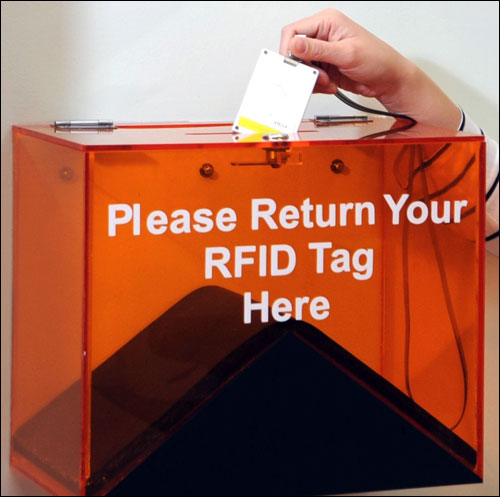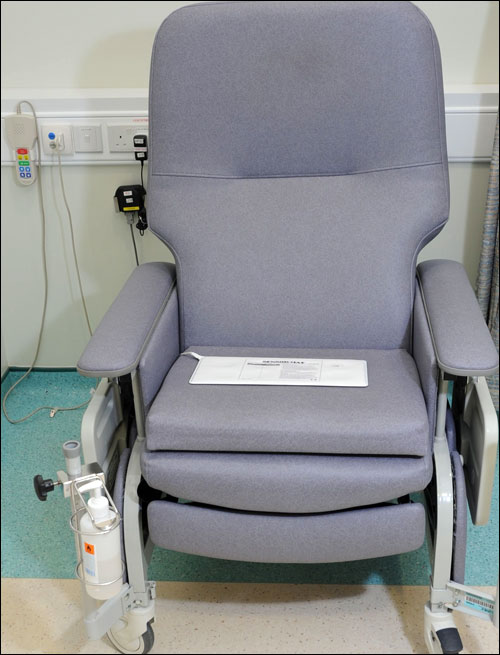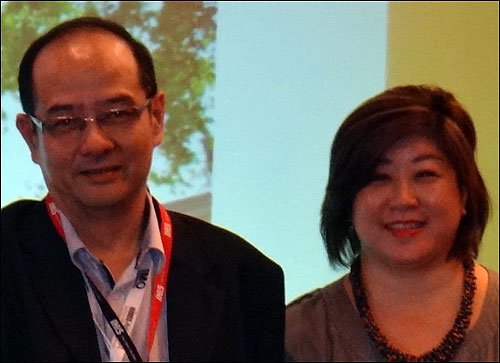Patients at the National Cancer Centre Singapore (NCCS) now have a shorter wait time at the facility’s chemotherapy unit, thanks to its use of active ultrahigh-frequency (UHF) RFID tags and readers. Since the system’s installation in 2011, the center has found that it can treat 20 percent more patients, wait times have been reduced by eight percent, and 56 percent of scheduled patients receive treatment within 30 minutes.
NCCS currently treats more than 35,000 chemotherapy patients annually. The facility has 54 chemotherapy chairs (also known as recliners) in which patients receive their chemo treatments during scheduled appointments. Without RFID, ensuring that an empty chair is quickly used by the next available patient, and thereby minimizing wait times, proved challenging for management. A staff member had to walk to each room and visually determine which chairs were ready for the next patients, and then notify those patients in the waiting room. This meant that chairs could sometimes remain empty for longer than necessary.
“Due to the complexity of the chemotherapy treatment,” says Mag Tan Wooi Lin, senior nurse manager at NCCS, “we needed a system that allows real-time views of our resources [the chairs] and appointments, so as to work efficiently and reduce patient waiting time.” The center began looking into an RFID solution in 2009. Eventually, it opted to develop a system specific to this use case, assisted by health-care IT company Integrated Health Information Systems (IHiS), systems integrator Singapore Communications (Wavex) Pte. Ltd. and software provider Evantek Pte. Ltd., according to Tony Liang, IHiS’ deputy director.
The resulting system, known as Real-time Ambulatory Patient Information Deployment Enabler (RAPIDE), would use active RFID to identify the locations of patients and personnel. RFID-enabled readers could then be used to confirm that an individual was sitting on a particular chair. IHiS handled the project’s development and installation, using RFID tags and readers supplied and installed by Wavex.
According to Mag Tan, Wavex and Evantek integrated the RAPIDE software with NCCS’ existing outpatient administration software, its queue system for identifying the order in which patients are received, and its SMS text-messaging system that contacted patients when their appointment was due to begin.
With the RAPIDE system in place, a patient is provided with a GT&T GTag-WP830B active UHF RFID tag, attached to a lanyard. A staff member links the unique ID number encoded to the tag to that specific patient in the RAPIDE software. The individual’s name is then color-coded in the software, thereby enabling workers to visibly identify his status—such as waiting for an appointment, or being treated.
In addition, nurses wear GTag-WP830B RFID badges so that the system knows where they are located when they are needed. This also enables the system to identify which nurse is with which patient, and thus which one the pharmacist should contact to collect drugs for a specific individual.

A total of 13 GT&T Glink-WC830D readers are installed in treatment rooms, hallways and waiting rooms to read personnel tags, thereby confirming those individuals’ locations.
When a patient enters a treatment room and sits on the chair contained within, a pressure sensor on that chair detects the person’s presence and prompts a custom-designed GT&T active UHF RFID tag, built into the sensor, to transmit its own unique identifier. The reader installed in that room receives the chair’s tag ID number, along with those of the patient and nurse, thus enabling the RAPIDE software to identify those individuals. The software forwards that data to the center’s queue software, which indicates the chair is occupied and, therefore, unavailable for use by another patient.
What’s more, the RAPIDE software updates the patient’s status as ready for the chemotherapy treatment. The hospital’s pharmacists can then view that data on their own computer, ensure that the necessary medication is prepared, and send a message to the nurse located in that patient’s room, instructing her to collect the required drug.
When the patient leaves the chemotherapy room after the drug has been administered, the sensor detects that she is no longer sitting in the seat, and that new status is forwarded to the software. She then deposits her tag in a box housing another RFID reader. When the system reads the tag ID inside the box, the queue software updates the chair’s status as available.

Mag Tan says the solution saves nurses approximately 825 hours of labor annually, since they no longer need to physically search for unoccupied recliners. It also allows for exceptions, such as a specific patient needing an extension in time, which a nurse can request via the RAPIDE software. The system then prompts the queue-management software to alert a staff member to reschedule the next patient’s treatment time.
Moreover, Mag Tan says, the system generates reports for NCCS analysis of workflows and patient loads, “to further improve efficiencies and drive down waiting times.” For instance, she notes, the center’s managers can identify when the system is experiencing a bottleneck—such as chairs not being made available for the next patient in a timely manner, for instance—and then address that problem.


